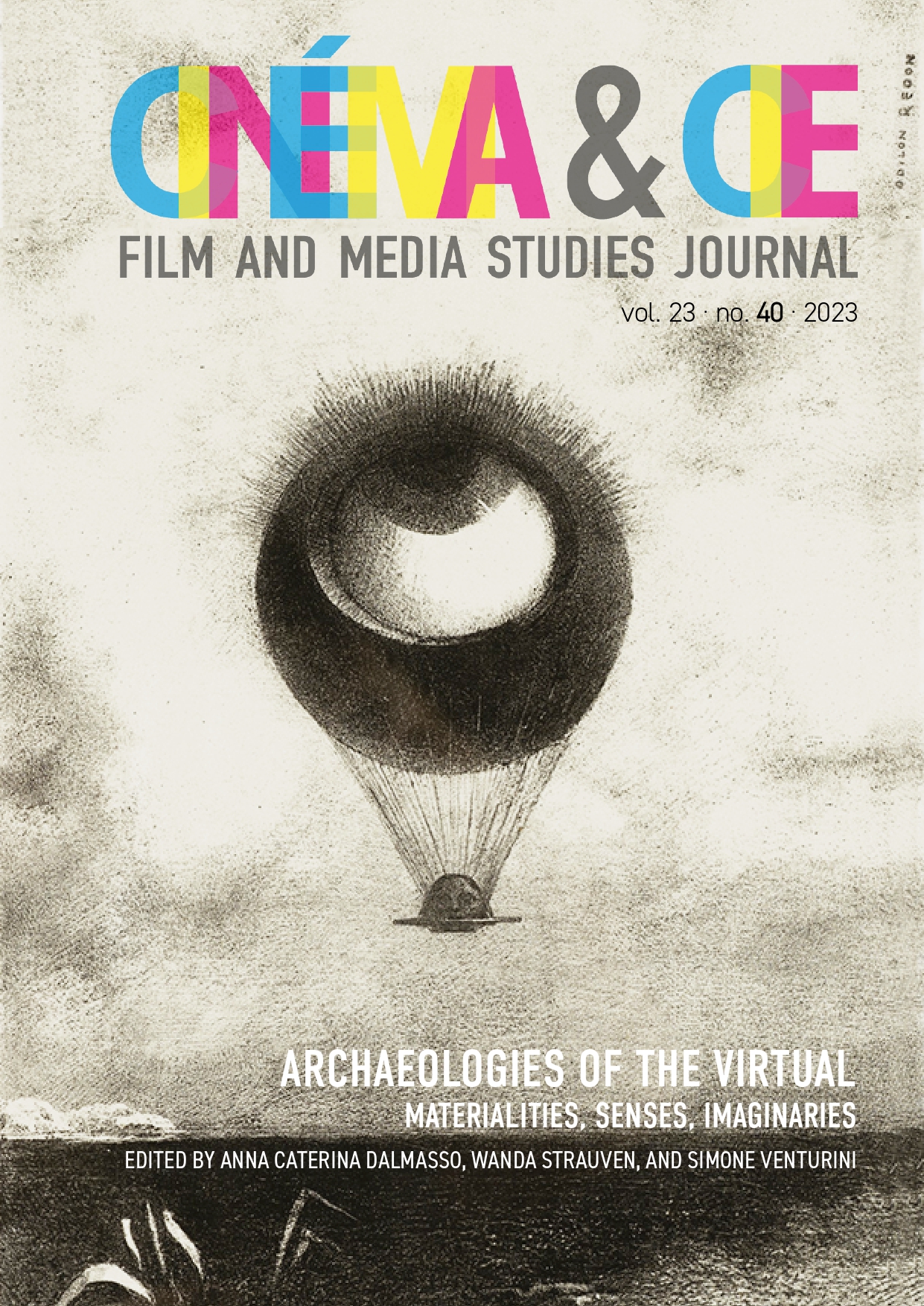Bursting into the Image: Towards De-automatization in VR
DOI:
https://doi.org/10.54103/2036-461X/19444Keywords:
Char Davies’ Osmose, De-Automatization, Dehabituation, Perception, Lived BodyAbstract
The art installation Osmose (1995) by Char Davies, one of the most widely discussed media art projects, will be explored in relation to the notion of de-automatization. The de-automatized experience in Osmose will be developed by looking at theories of perception by Arthur Deikman and Maurice Merleau-Ponty, as well as George Stratton’s inverse goggle experiment, Bernard Stiegler’s account of automation, and Gilles Deleuze’s writings on the virtual. The article traces a double act of de-automatization in Davies’ Osmose that occurs due to the indeterminate object relations in the multi-media installation on the one hand, and their intertwinement with the organic sensing body on the other. This leads to an ungearing of one’s habitual perception, that produces a particular relation with the virtual dimension. By outlining the theoretical framework of the intertwining between technical object and bodily experience in Osmose, it becomes possible to speculate on the trajectory of contemporary VR experiences. Whilst the contemporary VR scene still relies heavily on the privileging of the visual dimension, the project We Live in an Ocean of Air by Marshmallow Laser Feast shows how VR environments can ‘leverage on’ emerging technologies to re-produce nuanced deautomatized experiences. De-automatization unravels how the reception of the deautomatized VR image reframes relations between actual and virtual.
References
Aspden, Peter. 2018. “Virtual Reality: Marina Abramovic and Anish Kapoor at Art Basel Hong Kong.” Financial Times. https://www.ft.com/content/7f9d89d2-2c66-11e8-97ec-4bd3494d5f14
Bachelard, Gaston. 1994 [1958]. The Poetics of Space, translated by Maria Jolas. Boston: Beacon Press.
Davies, Char. 1998. “Changing Space: Virtual Reality as an Arena of Embodied Being.” In The Virtual Dimension: Architecture, Representation and Crash Culture, edited by Jon Beckmann, 144–155. New York: Princeton Architecture Press.
Crary, Jonathan. 1991. Techniques of the Observer: On Vision and Modernity in the Nineteenth Century. Cambridge, MA: MIT Press.
Davies, Char. 1995. “Osmoses.” http://www.immersence.com/osmose/.
Deikman, Arthur. 1972. “De-automatization and Mystical Experience.” In Altered State of Consciousness, edited by Charles T. Tart, 25–46. New York: Anchor Books.
Deleuze, Gilles. 1991 [1966]. Bergsonism, translated by Hugh Tomlinson and Barbara Habberjam. New York: Zone Books.
Gardner, Paula et al. 2016. “Body Editing: Dance Biofeedback Experiments in Apperception.” Proceedings, Part II, of the 18th International Conference on Human-Computer Interaction. Interaction Platforms and Techniques, edited by Masaaki Kurosu, 49–60. Berlin: Springer-Verlag.
Grau, Oliver. 2003. Virtual Art: From Illusion to Immersion. Cambridge, MA: MIT Press.
Gregory, Richard L. 1997 [1966]. Eye and Brain: The Psychology of Seeing. Oxford: Oxford University Press.
Gunning, T. 1990. “The Cinema of Attractions: Early Film, Its Spectator and the Avant-Garde.” In Early Cinema: Space Frame Narrative, edited by Thomas Elsaesser, 56–62. London, British Film Institute.
Hale, Jonathan. 2017. Merleau-Ponty for Architects. London: Routledge.
Hansen, Mark B.N. 2001. “Embodying Virtual Reality: Touch and Self-Movement in the Work of Char Davies.” Critical Matrix: The Princeton Journal of Women, Gender and Culture 12 (1-2): 112–147.
Leder, Drew. 1990. The Absent Body. Chicago: University of Chicago Press.
Luke, Ben. 2022. “Why Virtual Reality is a Medium still in need of ‘Cradling.’” The Art Newspaper.https://www.theartnewspaper.com/2022/06/17/why-virtual-reality-is-a-medium-still-in-need-of-cradling
Merleau-Ponty, Maurice. 2009 [1945]. Phenomenology of Perception, translated by Colin Smith. London: Routledge & Kegan Paul.
Schuler, Romana Karla. 2015. Seeing Motion: A History of Visual Perception in Art and Science. Berlin: De Gruyter.
Stiegler, Bernard. 1998. Technics and Time, 1: The Fault of Epimetheus, translated by Richard Beardsworth and George Collins. Stanford: Stanford University Press.
Themistokleous, George. 2021. “Keratoconic and (De)formed Vision: Re-thinking the Limits of Perspectival Drawing.” Drawing: Research, Theory, Practice 6 (1): 139–151. https://doi.org/10.1386/drtp_00056_1
Yong, Nicolas. 2022. “Nature Meets Technology in this Mind-Blowing Virtual Reality Experience.” 27 May 2022. Wonderwall. SG. https://www.wonderwall.sg/workplay/nature-meets-technology-in-this-mind-blowing-virtual-reality-experience/
Zylinska, Joanna. 2017. Nonhuman Photography. Cambridge, MA: MIT Press.
Downloads
Published
How to Cite
Issue
Section
License
Copyright (c) 2023 George Themistokleous

This work is licensed under a Creative Commons Attribution 4.0 International License.





